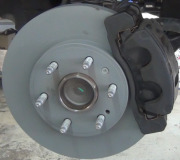I get the impression you think I said to do something at the master cylinder, then drive it that way. That is not correct. Once the brakes are locking up, stop on a slight incline, shift to "neutral", place a block about a foot down-hill of one tire, then open the front hydraulic system at various places to see where the brake fluid is being trapped under pressure. The easiest and fastest place to do this is right at the master cylinder. Loosen the two steel lines just enough to let brake fluid spurt out. If the brakes release, the truck will coast down to the block by the tire. That block is supposed to prevent you from looking funny as you chase after the truck! Another alternative is simply to have a helper sitting in the driver's seat who can stop the truck from running away.
If doing that does not let the brakes release, the next easiest place is the ABS hydraulic controller assembly, when there is one. Follow the steel line back from the left front caliper to that assembly and loosen that line there. It's harder to figure out which line is for the right front. Just loosen all the line nuts a little to see if the brakes release. It's best to loosen a line, then retighten it right away. That lowers the chance of air sneaking in.
The most tedious is to loosen the bleeder screws at the front calipers. If only one front wheel is getting hot, that's the one to open the bleeder screw on. This is where roughly half of locking brakes will release, and a real common cause is a restricted rubber flex hose. This has happened to me multiple times on my older Dodge Caravans, especially after I let them sit over the winter. The fix on those is very easy. If you look at the photo below of your front brake hose, the arrows are pointing to two metal brackets crimped around the hose. This is the first time I've seen two of them on one hose, so you have twice the chance of this happening. Rust builds up inside those crimps, constricting the hose. You can easily force brake fluid through that restriction with normal pedal pressure, but the fluid won't release freely. It keeps that brake applied, then heat is generated. That heat migrates into the brake fluid causing it to expand and apply that brake even harder. When this gets bad enough, that wheel will cause a harsh thumping felt in the steering wheel, and that wheel will get very hot. With a hose constricted like this, the only place you can release the trapped pressurized brake fluid is at the bleeder screw on the caliper.
There are mechanical issues with the calipers that can also cause these symptoms, but you already have new calipers, so that shouldn't be part of this story.
Also, it sounds like they're going in too many different directions trying to solve this, and they're introducing too many variables to the point we won't know what the final solution is. This is the second time today I've seen a reference to new wheel bearing / hub assemblies in relation to overheated brakes. The wheel bearings have nothing to do with that. Draining the fluid is also not going to prove anything. Every year I did a demonstration for my students to show how critical it was to prevent contamination of brake fluid. I used two beakers filled half way with fresh, clean brake fluid. I dropped a rubber lip seal into each one from a wheel cylinder rebuild kit. In one of them, I added one drop of engine oil or power steering fluid, then we let them sit for one week. At the end of that week, the non-contaminated seal felt the same as a new one once washed off with water. The contaminated one had grown by about 20 percent, and was slimy and hard to hold onto. That rubber compound is not compatible with petroleum-based products. Brake fluid is a glycol product which is very different. Also, I had to mark the contaminated beaker because you can't see it visually. That's why draining the brake fluid to inspect it is not a valid observation.
This contamination is such a big deal, back in the '80s when it was common to rebuild wheel cylinders and calipers as part of a standard professional brake job, we even washed our hands with soap and water before handling the new rubber parts, to prevent getting fingerprint oil on them.
Back to those hoses, when they became constricted on my vehicles, I found all that was needed was to open up those crimps a little with a large flat-blade screwdriver, or a large pair of pliers. There was no need to remove a wheel, but I did have to lay on the ground to do that. Your metal brackets look rather beefy, so I don't know if bending them to open them up will be possible.
Don't go replacing a pile of random parts. That is the least effective and most costly way to solve this. Instead, just tell me where something in the hydraulic lines can be opened to let the brakes release.
Image (Click to make bigger)
Thursday, October 19th, 2023 AT 3:13 PM




